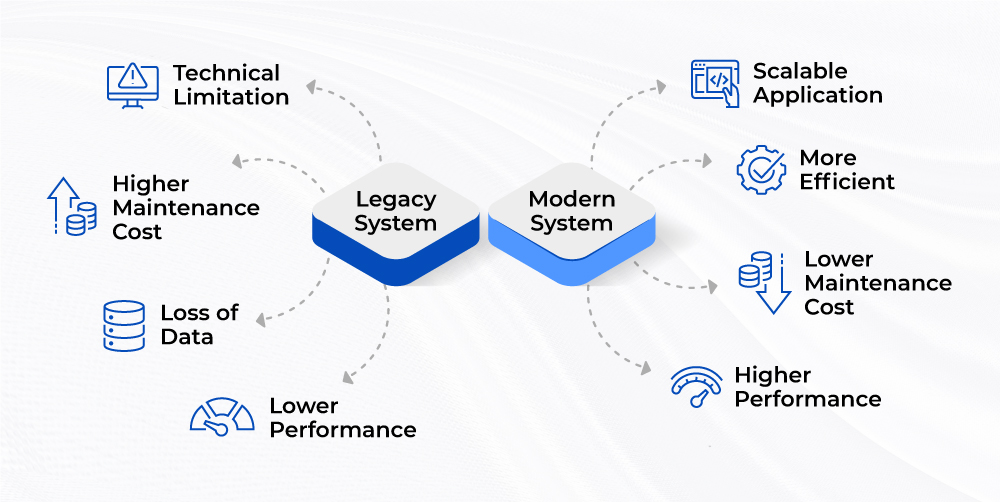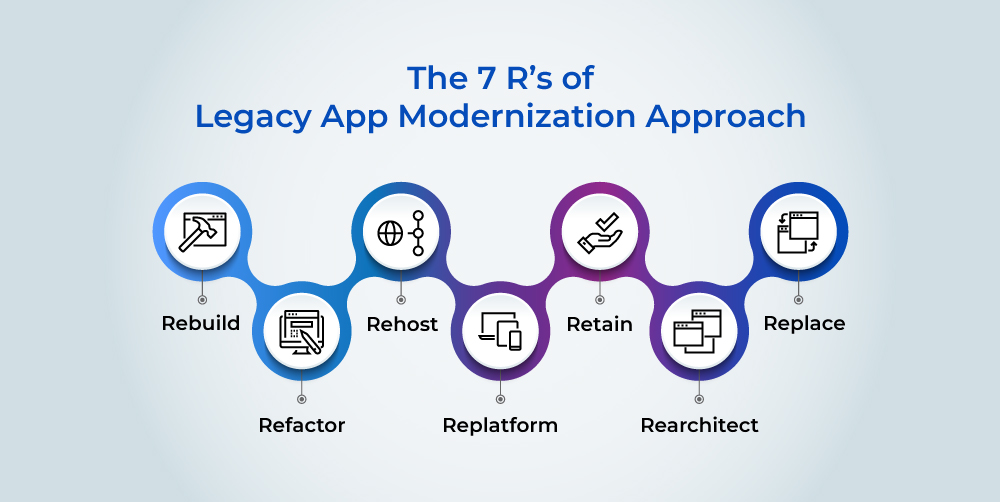
How the Retail Industry can Transform Legacy Systems?
The retail industry is highly dynamic, where customer preferences keep changing, so retailers need to modernize the application portfolio to operate at the pace of business change.
For retailers, legacy systems can restrict the growth of the business. Organizations can reduce IT complexity, increase efficiency, establish a data-driven culture, and improve flexibility across business processes by updating the old systems.
It is high time retailers modernize their software to optimize their operations and offer end-to-end customer experiences.
What is Legacy Application Modernization?
Legacy application modernization is the process of upgrading or improving existing legacy systems, applications, and processes with the help of modern technology that can support future digital endeavors. Modernizing a legacy system often involves reworking the code to varying degrees.
Legacy modernization helps businesses to boost agility, augment a business’s architectural load limits, enhance security, and enhance product quality.
Why Modernize Legacy Applications?
Over time, legacy applications start showing errors and critical issues that can impact your business efficiency. You need to get rid of legacy systems and digitally transform your business processes to improve organizational efficiency and gain a competitive advantage. It doesn’t mean you need to replace the whole system, but you need some kind of update to stay efficient and respond to market changes.

Organizations that modernize their legacy applications can enjoy a number of benefits:
Increased agility: Modern applications are easier to update and change, so organizations can respond more quickly to market demands.
Improved efficiency: Modern applications are often more efficient than legacy ones, so they can help organizations improve their bottom line.
Reduced risk: When legacy applications are updated or replaced, their risks are also reduced. This can help organizations avoid potential problems down the road.
Legacy Modernization Approaches
To ensure that the value you spend on legacy software modernization brings the maximum benefit, you have to carefully consider the right approach. Let us see what these approaches are:

Rebuild
Rebuilding a legacy system is perhaps the most expensive and the longest process but delivers the optimum results. The rebuild method transforms legacy processes into fully integrated cloud-native environments. Redesigning your system helps you leverage the capabilities of modern technology and third-party platforms.
Retain
Some businesses know that they will either close down operations or get acquired in the near future. In those cases, it makes more sense to stick with the existing system rather than spend the money on modernization.
Rehost
This legacy modernization approach allows legacy applications to function in the cloud infrastructure without major changes to applications. Some code parts can be rewritten as needed. This technique is of the lowest cost and risk.
Rehosting can be a good option for enterprises that want to improve the performance of their applications. While redesigning the system can take years, rehosting is faster. Organizations can retain their investments in legacy processes and simultaneously avail themselves of the benefits of the cloud infrastructure by rehosting. Rehosting is also called the ‘lift and shift’ approach.
Replatform
This process includes moving an existing legacy system entirely to a different platform while the features and functionalities of the apps remain the same. Using this approach, improved performance can be leveraged with minimal infrastructural costs.
Refactor
Refactoring is generally used in hybrid environments where parts of the legacy systems are code optimized to improve performance. Refactoring is generally carried out by improving the existing code, typically in the backend but keeping the front end or the functionalities unaltered.
Many organizations prefer this approach because the process is less disruptive than a complete rewrite.
Rearchitect
This approach involves shifting to a new application architecture while altering the legacy code structure to fully utilize the platform’s new capabilities. This technique has medium cost and risk but also medium results.
Replace
This approach involves discarding the existing system and implementing an entirely new system for optimizing business processes. Replacing legacy system often call for a complete process redesign to bridge all kinds of gaps in the operational process.
The right strategy will depend on a business’s goals, IT infrastructure, and finances. IT leaders need to carefully analyze the pros and cons of every approach. It is important to know the challenges and determine if a legacy modernization approach could be applicable to your business.
Upgrade Legacy Systems Using Low-Code
A legacy modernization consultant can also provide clarity and help you in your legacy modernization journey.
- You can leverage Reusable Components & Data Models.
- Eliminate the hassle of writing lengthy codes.
- Low-code makes it comparatively easy to upgrade the legacy application to suit modern enterprise needs.
- You can utilize the AI feature to code specific parts of software with the automation sequence and accelerate application development.
How To Ensure Your Transformation Goes Smoothly?
Assess the current state of legacy systems
Legacy software does not always fall under the category of “old” or “outdated”. There are more aspects to assess when finding legacy systems. Thus you need to assess all systems and software in use to uncover the current and potential issues it can cause in the near future. Analyze all aspects of your technology by taking into account your future business plans.
Select the modernization approach that would be the fastest to deliver value
Choose the modernization approach that best suits your needs and will help you deliver results fast by analyzing the seven modernization options in terms of their effect on technology, functionality, architecture, cost and risk. Ultimately, modernizing legacy system means choosing between rearchitecting, rebuilding or replacing.
Choose the technology stack to deliver optimal performance and user experience
When redesigning your system, make sure you use a reliable and future-ready technology stack. The technologies should be selected based on product specifics. The right tech stack contributes to creating a reliable and efficient system.
Conclusion
Modernizing a retail legacy system isn’t easy, but it’s worth it. With the right strategy in place, you can ensure that your business will be future-ready.
We at OmnePresent handle every aspect of legacy-system modernization: from analyzing the current solution, developing a business strategy, and rebuilding your product from scratch using the latest technologies and architecture solutions. We have helped retail organizations with our breadth of legacy modernization services and helped them in their digital transformation journey.
Our experts help you reimagine your core IT systems with agile and resilient legacy modernization solutions to meet increasing business demands and minimize transformation risks.
RECENT POSTS
CATEGORIES


